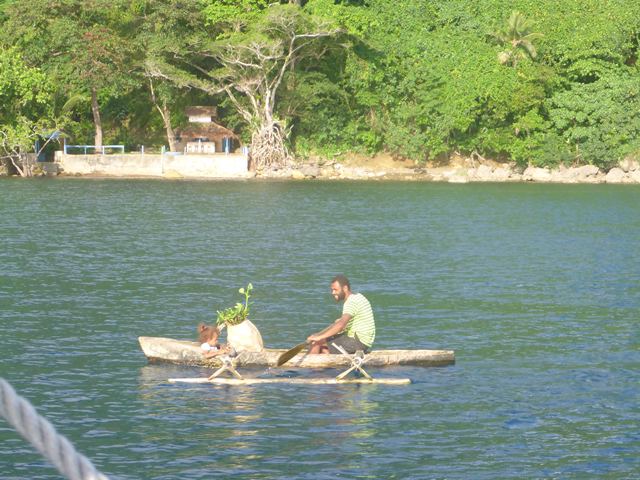Our three little dinghies sped across the blue bay in a mood of Swallows and Amazons Adventure and we slowed down, unsure of the bottom contours when we entered the narrowing river. I was reminded of other excursions into unknown waterways, remember Las Perlas? But here we should not find any salt water crocs. Although the possibility is not unknown when cyclones have been known to push crocs off course from the Solomon Islands to the north.

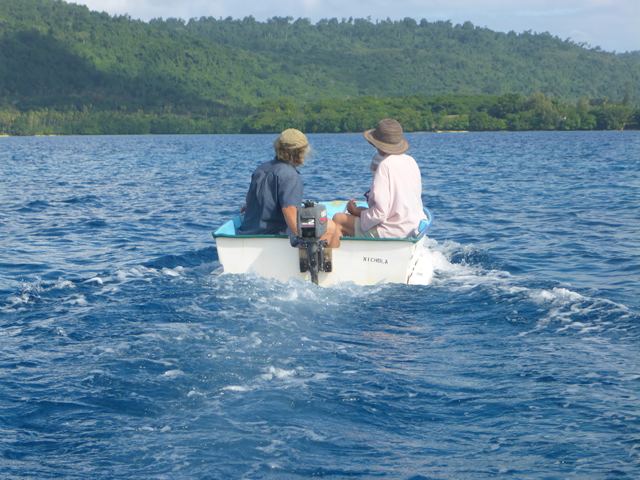

A likely landing place among the waterside jungle of banyan, hibiscus, mangrove and palm was a pretty clearing with the ruin of a home set in a cleared parcel of land above the riverbank. People lived just down the hill in a traditional woven bamboo hut but this building, as you can see has concrete walls set with stones suggests foreign hands and was built to last. Many such ruins exist from the pre-1980 independence years and after that date settlers from Australia had to go home, leaving their tropical paradises behind.
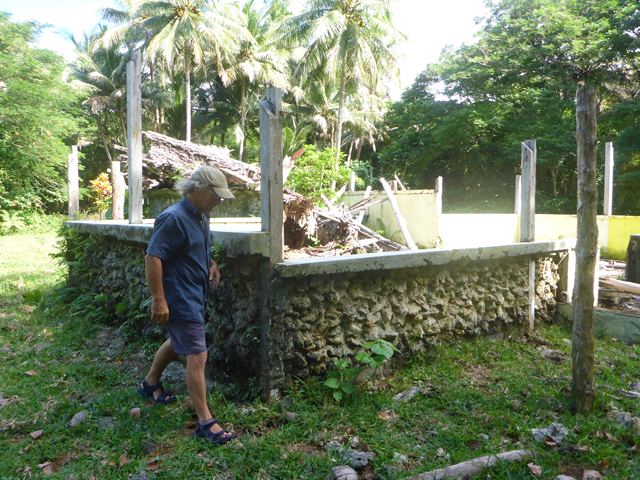
The enclosure was fenced and behind it a small plantation dotted with piles of de-fleshed coconuts told the story of an income at least partly from copra. Cattle is another export, especially to Japan and kava to Luganville and Port Vila for domestic use and export to the Vanuatan diaspora.
The leaf that Ken is touching closes instantly when in danger and the area was full with jungle trees and colourful plants. There must have been some regret when the residents left.

Back in our tenders we made our way towards the old wharf, stopping abruptly when we saw that since our passing a fishing net had been laid right across the river and we paddled ourselves across it with the outboard tipped inboard to clear it. Safely on the beach near the well spread village we wandered up past grazing horses to the track. Outside one hut fresh green woven baskets full with papayas, breadfruit and bananas were being loaded on to a pickup truck to go to market. A smiling old man came toward Bron and me and gave us each a grapefruit as a gift with a beaming smile. We chatted briefly, shook hands with him and lots of other folk of all ages. Those grapefruit were so sweet they needed no extra sugar.
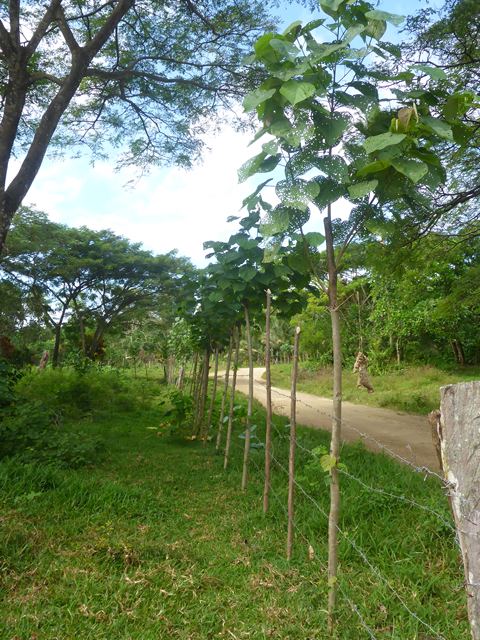

We found the shop again so Bron could buy some cans of beer and then we all bought some pak choy from outside a ladies hut and made our way back to the dinghies. Bron and I were a little troubled by the attitude of our companion who viewed all villagers with suspicion and mistrust. “Make sure you wash your hands,” I was advised after shaking hands with some children. Her feelings were based on experiences of having been approached while on their boat and asked for items based on the assumption they were wealthy, leading to a feeling that they might be exploited. Had she by different fortune been born in their shoes I wondered if she would have asked for some meagre item like old rope or unwanted clothes to improve their modest lifestyles. There’s no harm in asking as long as it stays short of harassment and we never had problems with that. More often than not they gave us gifts of fruit and veg and welcomed us to their shores.
What concerned me was the biased and unjust reports she would make to her friends about these kindly people.

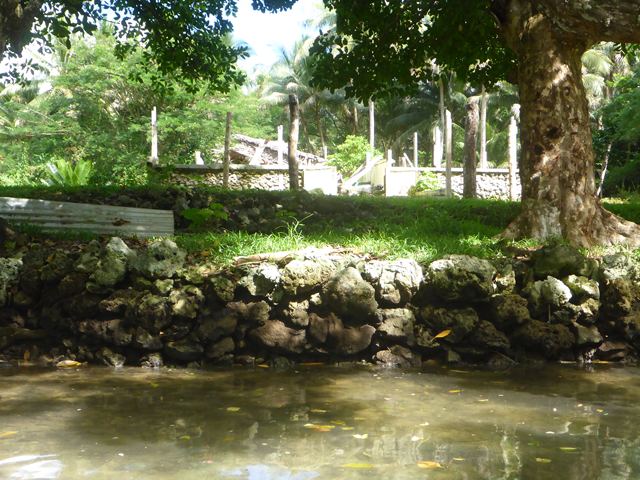
Punching towards Naone on Maewo Island.
We were all up around 6.00am with the first light giving us good vision for leaving our sheltered lagoon. We knew we had a battle with the SE Trade Winds ahead of us but we had been long enough in Port Olry, so long in fact that we realised our planned trip into Big Bay would just mean more head wind bashing and possible time delays when we came to leave there, so regrettably we gave the Nature Reserve a miss and hoped for tropical jungle elsewhere.
There were 55 miles between us and the north end of Maewo to the east and the chunky sea foretold the strength in the wind. Early on we actually managed to fill the reefed genoa and a handkerchief of main with a beam wind for a few minutes before the wind did a backward flip of 90’ to head us and away went the sails, but not before noticing the seam above the O logo on the mainsail had opened completely. “The repair we had done in Guadeloupe was only one row of stitching per seam.” Rob exclaimed to my astonishment. So the sail will have to come off, probably in New Caledonia for repairs and until then we can use it reefed in to the end of the open seam.
Ken and Bron’s Nichola is a spirited steel 32 footer and she gained on us under sail while we were faster under motor so we were never far apart until later on this long day when we decided we should get anchored in daylight so we could be a beacon for her to sail towards.
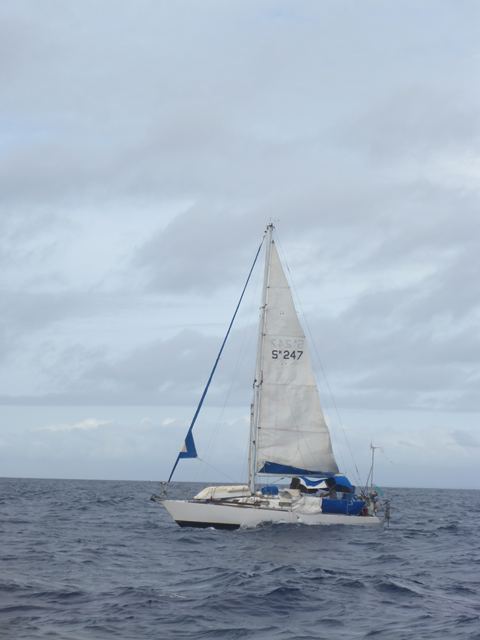
The waves hit Zoonie on the starboard bow and she pitched over them and into the troughs shooting white spume outwards sideways. I was reminded of the day, off the Portuguese coast when we had to motor hard for 10 hours into a headwind and torrential rain to reach Peniche, so it doesn’t often happen.
We needed to locate Zoonie to the left of where the waterfall enters the sea where we would find black sand and mud, but in the failing light where was the waterfall? We saw a flat area of rock and it looked like water passing over it so there we laid the anchor and rolled uncomfortably. Our pilot book told a different story ‘Its west coast provides delightful cruising since it is protected from the full blast of the trade wind and there are no waves since the wind is offshore,’ well maybe that was so when the author was passing!
Two hours later Nichola’s steaming lights appeared and she tucked herself in to shore from us and rolled even more. This all boded for an uncomfortable night ahead. Thor had made her way to Ambae Island so we would not have her company.
Cook spotted the island in 1774 but like Bougainville six years before him neither of them landed. And neither did we. The island is rugged and narrow, no more than 5 km across, so not much protection from the trade wind even on the leeward side where we were. Also with 177 inches of rain each year it is the wettest of the Vanuatan Islands, so few foreign settlers came to live there.
Consequently traditions and customs are still alive and well there including dancing, the grading ceremonies where men achieve higher status by laying on ceremonies where many pigs are killed, the ‘hurter’ men who poke one sometimes very painfully with sticks between April and August while dressed in sacks and banana leaves; a tradition based on the exclusively male secret societies of the past and magic which enabled men and women to harm and even kill their rivals. We saw no evidence of magic or the hurters while we were on the island, fortunately, but the grading tradition is still carried out and on some islands woman are allowed to achieve higher status grades too.
The discomfort continued for our two friends as Nichola’s shorter hull rolled in the swell while the breakers pushed her mercilessly. By the next morning I felt like a well rolled Havana and Rob, with a thick head and blocked nose felt like 007’s martini, shaken but not stirred!
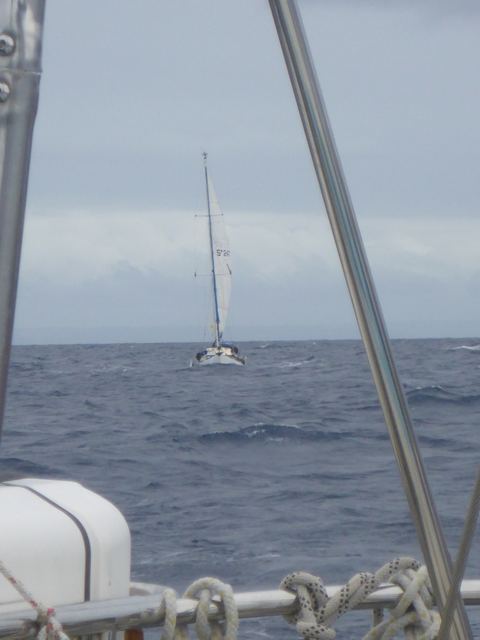
Back in Cook’s time it is reckoned there were 20,000 people on this island measuring only 56 km from north to south but with the contact with foreigners who brought disease and the French who took by force the male villagers for cheap labour in the plantations (black birding) this was reduced to 2,500 twenty years ago. However since then, despite a broader education giving young people the choice to stay or move to the cities, the population has increased to around 11,000. The more relaxed and less money hungry lifestyle is an understandable choice.
We were not feeling any more relaxed yet as we headed south towards Narovorovo with the hope of a sheltered bay. We were not disappointed, and the village area looked like a park, well grazed by the cattle and the top of the beach was bordered with beautiful mature trees including giant, ancient banyans with their generous shade-giving canopy and mangoes bearing what promised to be a good season of fruit, just not quite ready yet.

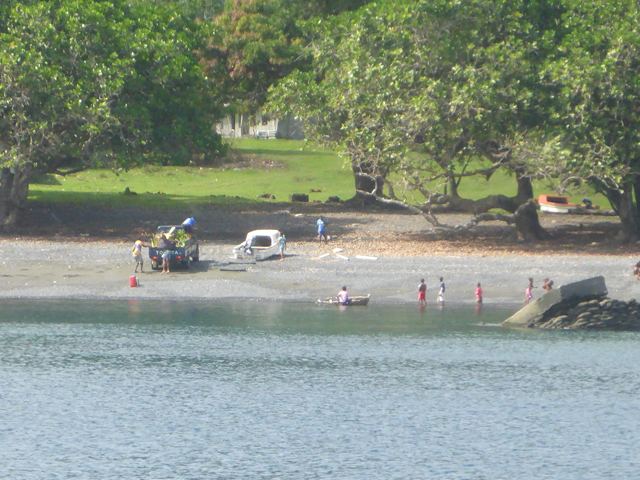
We motored close to the highly visible and magnificent Bastion Rock you see in the photos, keeping a wary eye out for the reef around it. Where ever there is habitation the Mile a Minute creeper, introduced by the Americans to camouflage their equipment in the Second World War, which has now spread throughout the islands, is kept at bay but elsewhere it appears to be smothering the jungle. Maybe someone has done a study to discover the harmful/beneficial effects it is having on the ecology.
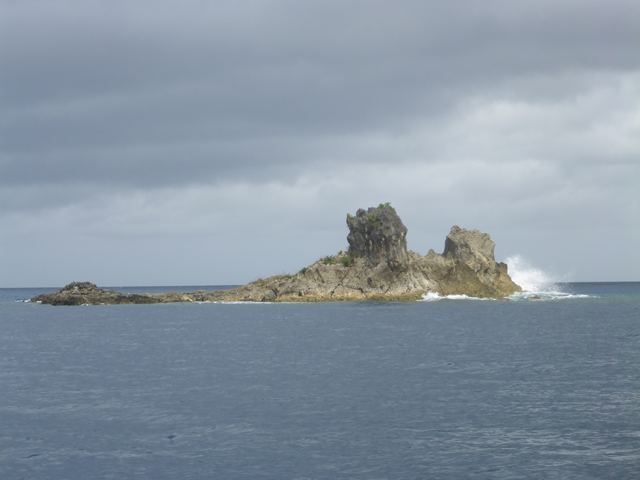
Alfred came down the beach along with a delightful throng of children keen to help with the dinghies. Alfred showed us all around the village, gave us the freedom to stroll where we wanted and introduced us to some of the ladies and young men. The river was not used as drinking water because of the grazing cattle, instead drinking water is piped down from further upstream. The washing is done here though, with children rubbing clothes against the wooden wash boards while sitting mid-stream and then drying it by laying it out over the clean warm volcanic beach stones (pumice). Ken and Bron gained permission to do theirs the next day.
Two Ladies of Narovorovo – Lily Grace and Shirley
Albert told us there would be a market around 4.00pm and we would hear the bell being sounded (long empty gas cylinder, hanging from a tree) when the time was right to come ashore again. We saw these old gas cylinders hanging in many villages and they are used to send signals and tell the time just like the church bells once used in English villages. But the sound was not forthcoming, so Albert called to us and waved us ashore.
While waiting Albert introduced us to Lily Grace, a widowed grandmother who with the help of her grand-daughter was preparing the evening meal. The little girl aged about eight was slicing choy by holding it in her hand and using a machete with confidence and precision. Lily had peeled taro root and hollowed out the centre keeping the outer layer to use as a lid. She would then put coconut milk in the hollow, replace the lid and roast the roots until they were cooked through, roasted outside and steamed inside. Sounded delicious.

Close by other young grandchildren were playing on the level concrete surface of her late husband, Jean Paul’s grave; their grandfather who would never be alone as he lay just outside the home they had shared. Another son sat on the tomb grating coconut flesh into a bowl and I was reminded of Fulunga in Fiji last year, when Jone used to grate punnets of the pure white flesh for us.
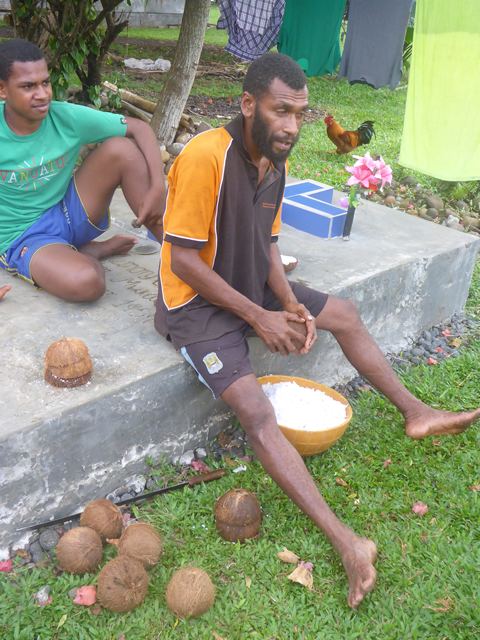
Piles of chopped Kava root lay drying in the sun ready for export to the cities; the villages cut fresh each day for their own consumption in the numerous kava bars throughout the villages during the evenings.
We cooled our feet in the river chatting to the girls and learning about which was their favourite subject at school. The sturdy old stone bridge had been washed away when the overflowing river powered downhill after a cyclone and now vehicles drove across the river a little further upstream.
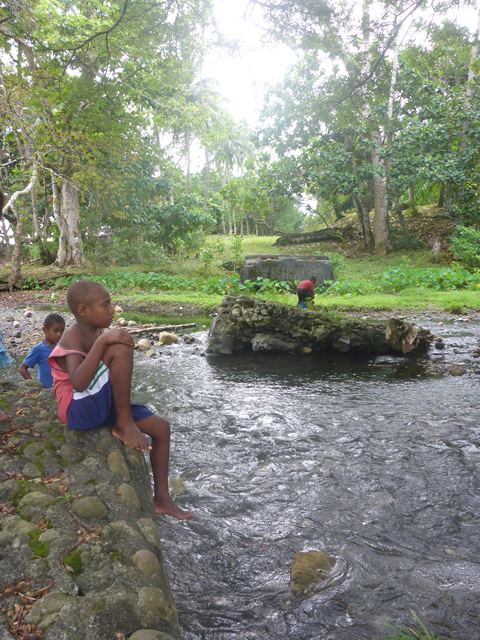
A new youth house lay incomplete for lack of building materials but the ladies were arranging a ‘bring and buy sale’ to help pay for the new ladies meeting house.
Each village is arranged slightly differently in the way they keep their animals. Here the cattle and chickens wander free and keep the grass short and well fertilised, the chickens clearing up the cow dung as they peck around, each hen with her brood of chicks. While the pigs are fenced securely in the coconut plantation behind the village where the men tend the new crop. Copra is big business because of the growing demand for healthy oils and within the village are plentiful lime, lemon, avocado (later in the year), grapefruit and bananas and coconut in abundance in the plantation.
The village homes were laid out in neat rows and a communal cookhouse and bread oven were in daily use. Larry opened the shop for Bron to buy a few items and then we went into the present meeting room to join some ladies also waiting for the market produce to arrive. I sat down between two ladies and we started chatting. Shirley was a trainee primary school teacher with 48 children in her class.
While we chatted a young lady offered us cooked crayfish from the river sitting on roasted coconut flesh and topped with coconut cream. It was flavourful. I mentioned to Shirley the items we had brought from NZ to give to villagers who might need them. Stationery and writing materials, bras and spectacles and a big bag of clothes from Martin and Renata to name the main items. When she said “There are many old ladies here in the village (of 200) who need glasses,” I was relieved and delighted. We arranged to bring them ashore the next day.
There was not much happening in the market so we made our way back to the boats to prepare for another lovely shared evening with Ken and Bron, taking turns to entertain with us. We had plenty of help to launch the tenders from the willing and smiling children.

After a wonderful still and restful night Sunday dawned with the sound of chanting from the Sunday school taking place under a giant banyan tree above the beach. The ‘gong’ summoned folk to the church service. Shirley was amazed when I told her there were three or four services on a Sunday in Fulunga, the little island we visited in Fiji, “How boring!” She exclaimed.
She showed us into her new home that she only moved in to three months ago and next to it was her mother’s old house where she was born and raised.

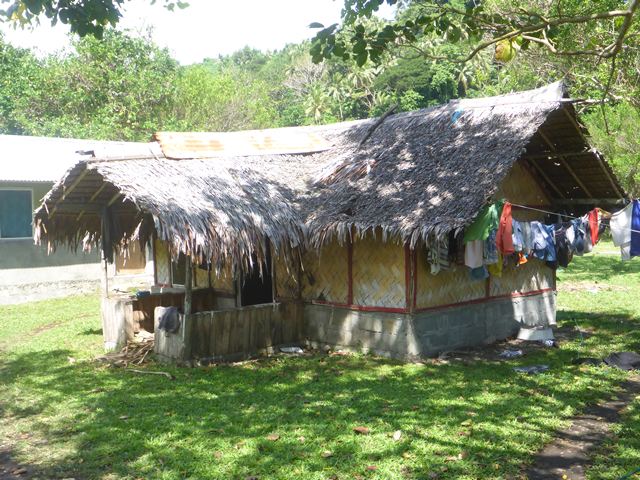
“The old ladies are keen to try the glasses,” she said and I only hoped they would help their eyesight.
While in her teens her father obtained a job in the government on nearby Ambae, scene of the evacuation in 2017 and 2018 after the volcanic eruption. But Shirley left Ambae to return to her birth village when her teacher mother was dying. She clearly loved and missed her mum. Her new home was decorated with all the colourful wall hangings her mother had bought in readiness for Shirley’s marriage. On this island marriages are arranged and this union was not a happy one.
Shirley even referred to her husband as ‘lazy’ and there was no love lost between them. “I have my two children and my new home and maybe a job, so I am happy.” She had a vacant look in her eyes and I felt for her.
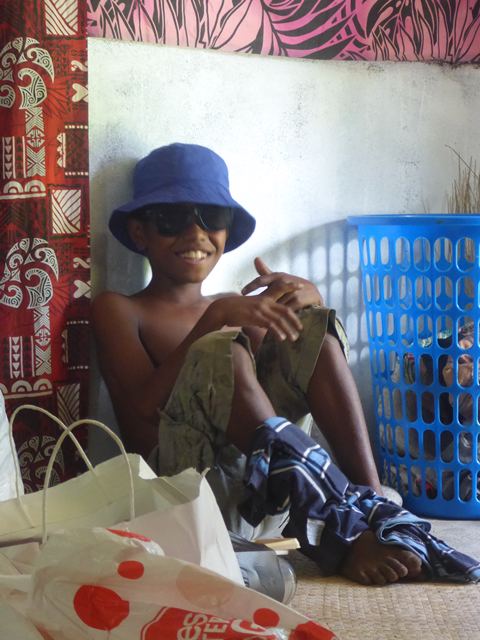
“Nice clothes,” she said almost to herself as she slowly went through Martin and Renata’s bag, and when she came to the stationery, “Ah good, pencils, the children keep asking me for more because they eat them!” She had prepared a snack of roasted wild yam with coconut cream and it was very welcome.
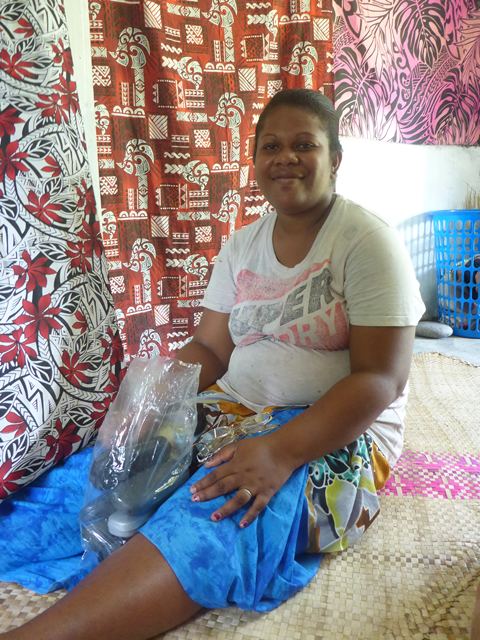
She told us the story of how when she was first married she kept pigs and asked her husband to build her a pen for them so they wouldn’t stray and damage neighbours’ gardens. But he never got around to doing this task and gradually the locals killed her pigs and finally the sow so although they compensated her she has refused to keep pigs again until she has a secure pen for them. Now villagers’ pigs are kept safely in the plantation.
She loves her teaching job and the children but the government is delaying making it a formal position. Shirley explained there is much self-interest and nepotism in government and the good jobs go to friends and relatives of the officials so she is afraid her job might be taken from her. If they do come good for her then much of her income must go to the village funds or she will be shunned. She is between a rock and a hard place it sounds like to me.
After she gets back from school she spends her time making the beautiful pandanus mats we have seen many times before. See on the picture how she weaves in different coloured stems and uses dyed chicken feathers as the fringe. She weaves a 2 X 3 metre mat in a week, it will grace the main room of her new home.
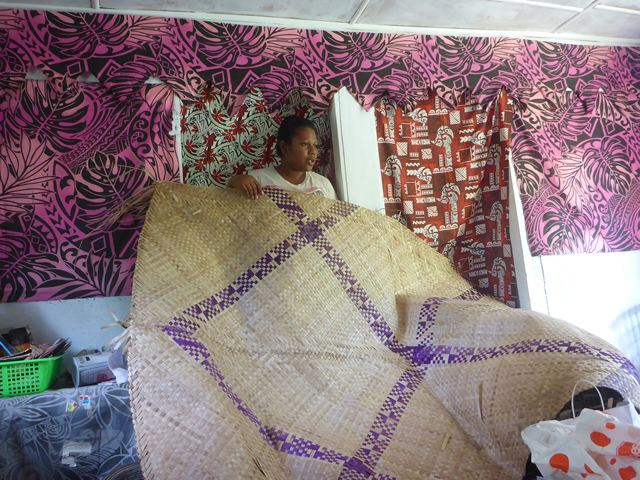
We were silently amazed to learn that they do not know how to milk cows so the animals are constantly being suckled by their calves and they allow the chickens to breed freely so instead of collecting eggs the chickens have three broods per year and raise all the hatched young, well at least they have plenty of chicken!
Shirley is the proud owner of the first house in the village to have a solar powered TV and in the evenings her main room frequently fills with children watching TV programmes.
She walked with us back to the beach and called her husband over to say hello before we left. He appears in the photo beside her.
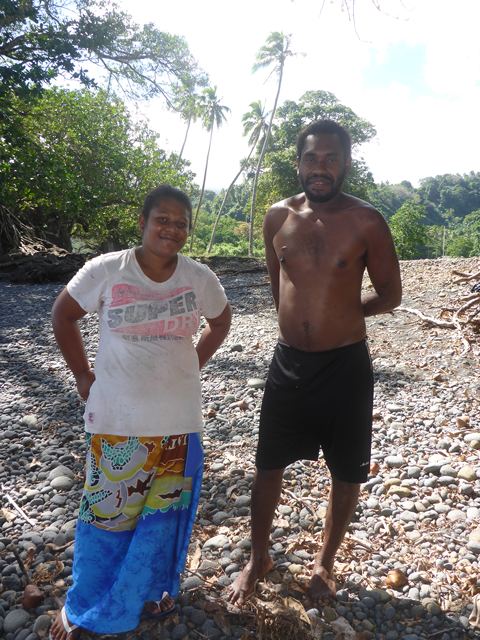
Light Winds to Ambae
Zoonie’s log records winds of 5 to 8 knots as we followed Nichola across to the little island where the sleeping volcano, Manaro Voui suddenly awoke from its slumbers in September 2017 and again the next year in August 2018. A pyroclastic cloud and toxic fumes forced the 11,000 strong population to scatter to other islands until the activity died down.
You can see why the American novelist James Mitchener referred to the island as looking like an upturned boat; from the photo it resembles a long keeled hull with a nice counter stern. He thought the island the most beautiful in the world but touring this fascinating archipelago as we are it is impossible to give one single island the honours.

We are discovering natural beauty, kind and friendly people, well-groomed villages and lovingly tended gardens wherever we explore. If one or two villages appear to be litter strewn it is packaging from trade products exported to them which they would not have had a use for in the past. The natural rubbish that comes from their home grown products is either burned on a daily basis or rots down over time. They need to learn from outsiders that modern rubbish does not decompose in the same way. If a very few villages appear untidy it is hardly their fault.
We approached two bays on the north eastern tip of the island and we had a choice. We could creep along the narrow transit where a shallow channel had been blasted through the dormant volcano rim into the deep secure lagoon in front of Lolowai village, risking touching the bottom estimated to be no more than two metres down, or we could anchor to the right of a high rocky promontory with plenty of room in effectively our own Vanihe Bay, so you would be right in thinking we chose the latter. The water was calm and the heavy black sand provided a secure holding and within minutes both dinghies were in the water ready for our first visit ashore.
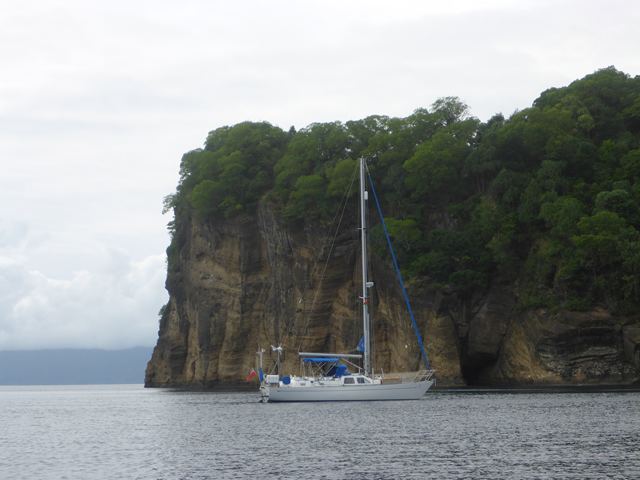
The very short journey around the heavily wooded promontory was awe inspiring. Beautiful mature and healthy trees of many kinds clung tightly to their unlikely bed and hundreds of fruit bats voiced their disapproval of our motors by wheeling and diving above us making a terrific screeching din. Satisfied they had made their anger felt they returned to their upside down position in a fine leafed pine tree, their blonde bellies and brown bodies noticeable against the soft green foliage.
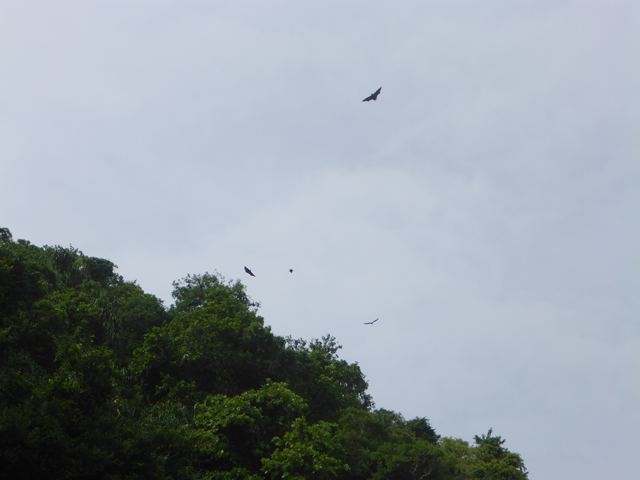
As we reached the end of the cliff face crabs of all sizes scurried up the burnt ochre ash rock and we could see this would be a spectacular place to snorkel.
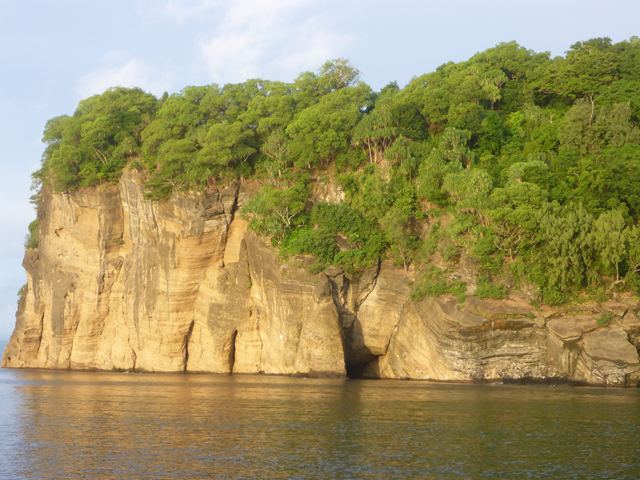
For fun really we lined up the dinghies with the two triangular transits and leaving the green buoy to starboard motored cautiously in to this new haven. The second pole had lost its triangular topmark but thoughtful locals had kept the undergrowth at bay and the pole was clearly visible.

Edison and his friends met us and we chatted a while. He told us 8000 of the islanders had returned as complete families leaving 3000 still abroad, many with children at the High School in Santo (Luganville, where we had cleared in, is also known as Santo as is the island it sits on Espiritu Santo). He had been back for seven months after his stay in Narovorovo. He gave us permission to walk where we wanted and we strolled to the well-equipped hospital and spoke with some of the staff there. A desalination plant and small field of solar panels provided by Japan were out of action for need of maintenance and spare parts.
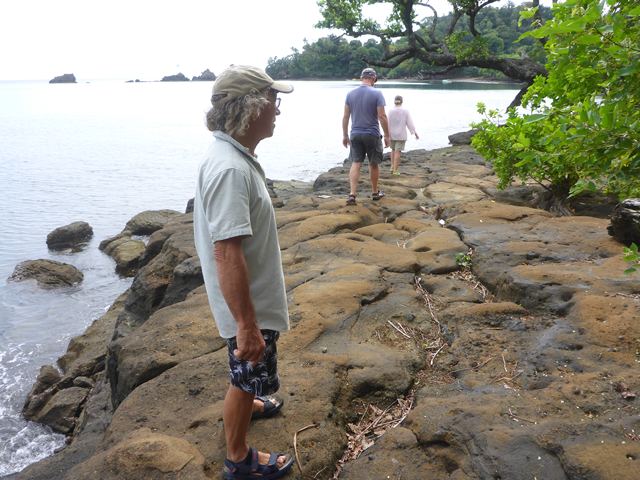
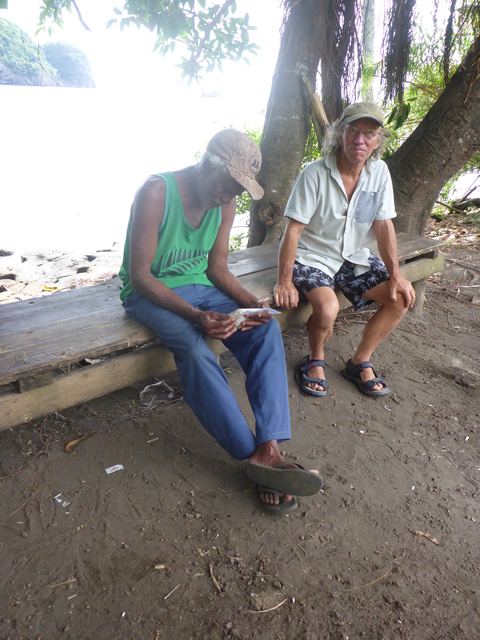

Under a giant banyan tree the daily market was laid out but we had plenty of papayas and kumara, however Ken rummaged in the undergrowth and found us a beautiful coconut which he then husked on his foredeck and loaned Rob his grater, so at last we had grated coconut once more. Memories of Fiji came flooding back again.
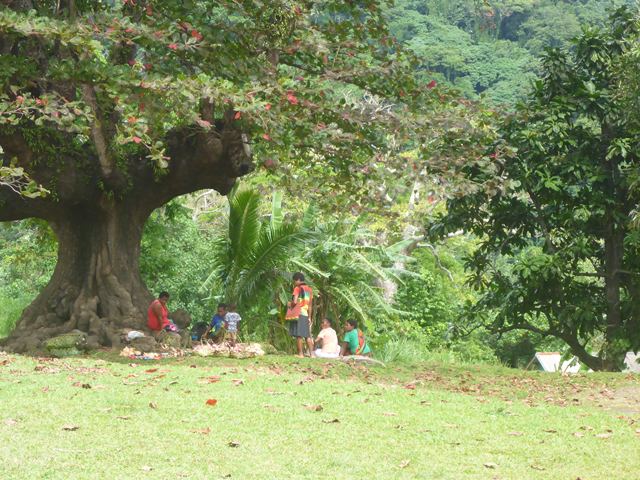
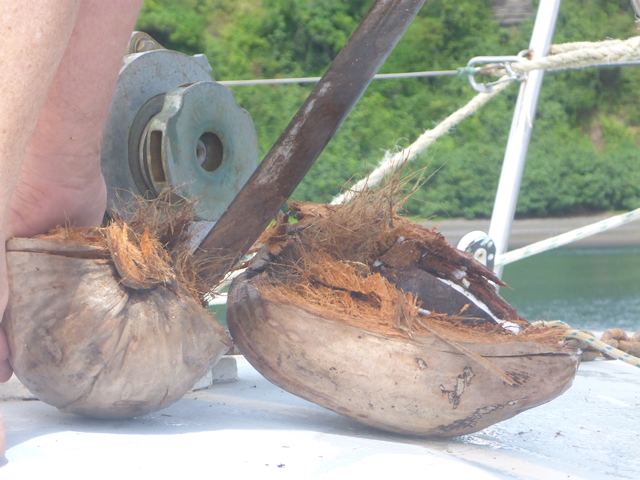
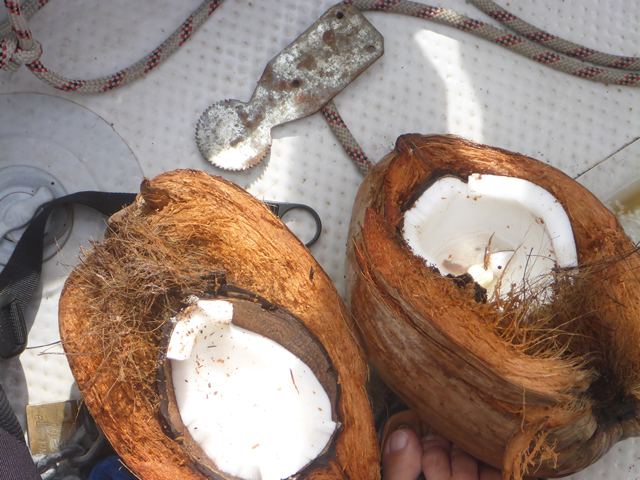
Legends are commonplace in these islands where natural processes are all powerful and people have created their own explanations for events over which they have no control. One legend concerns the Lombenben volcano and its lakes. The cultural hero of the island, Tagaro who is thought to have arrived from Samoa around 1400AD may well have found inhabitants here already. Carbon dating suggests the Lapita culture were in the area before 500BC.
The legends tells how Tagaro removed the volcano from Mt Lombenben and planted it on Ambrym, then drowned the three main fiery vents by submerging them in water, the two largest of the three lakes within the caldera representing Lombenben’s eyes.
Another delightful legend tells the story of chief Vevineala who had risen through his four ceremonial grades to the top. With many pigs (apart from the 25 he had killed at each of his four grade ceremonies) and 10 wives he was wealthy but childless. One day he was on his way to trade pigs on Maewo Island when his clothes slipped revealing he was in fact a woman; with considerable pig breeding skills it seems.
There was a particular reason we were really pleased to have anchored in the bay instead of the lagoon. That evening Ken and Bron came to us for supper, this alternating of evenings on eachothers’ boats was becoming a delightful habit. We sat in the cockpit supping gin cocktails when we witnessed one of the most beautiful sunsets we had ever seen and would have missed if we were tucked behind ‘fruit bat hill’. The photos will testify.
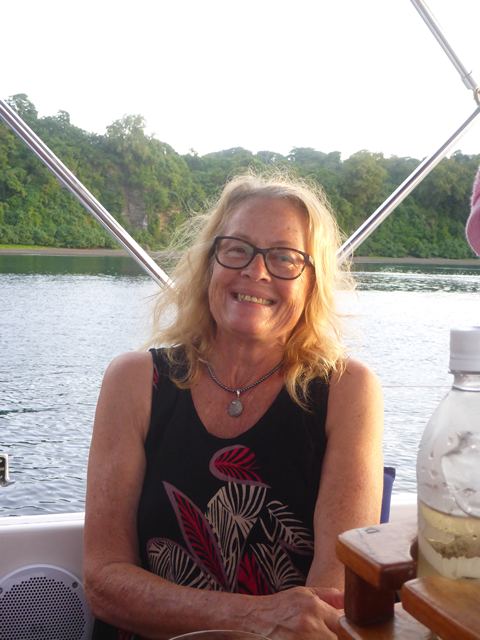


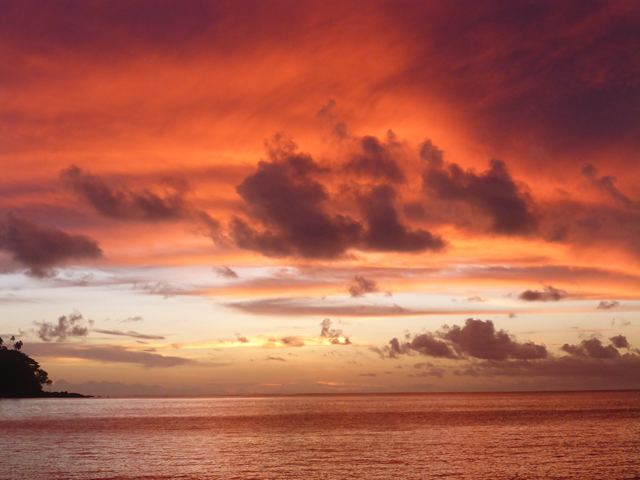
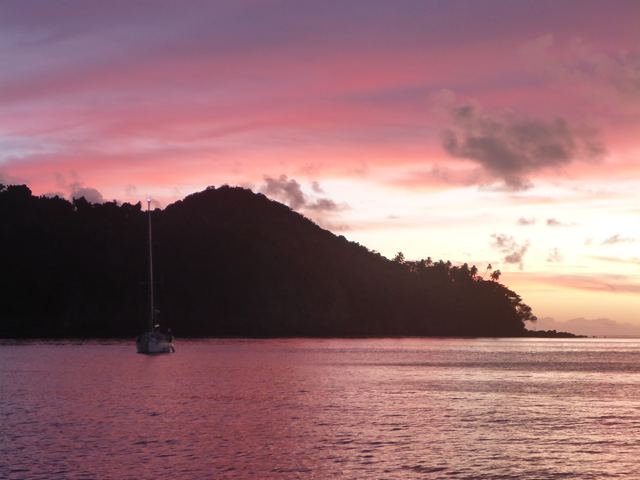
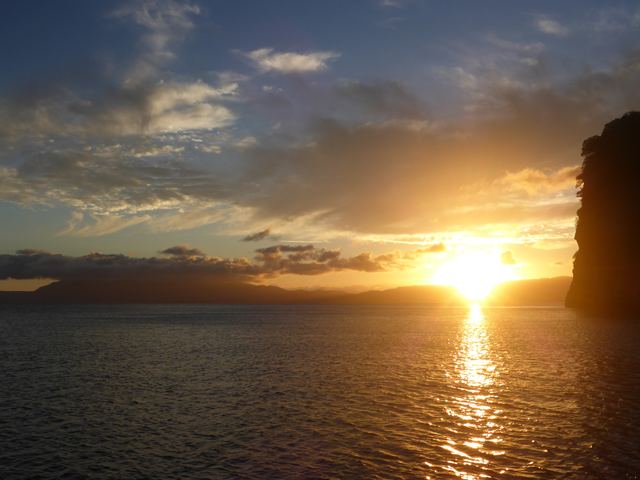
Next day we were ashore early, bats allowing, to save the midday hours for a snorkel. The charming lady in the shop came up with fresh eggs but no bananas so we went walkabout up the track leading away from the village and back towards our bay. Back near the shore and laden with sufficient bananas and coconuts, we met a young man helping a little old lady who was clinging for dear life on to her zimmer frame. Her pretty face revealed a life of struggle which was now replaced by a dependence on her family to look after her and judging by the tenderness the young man was showing her she would be alright.
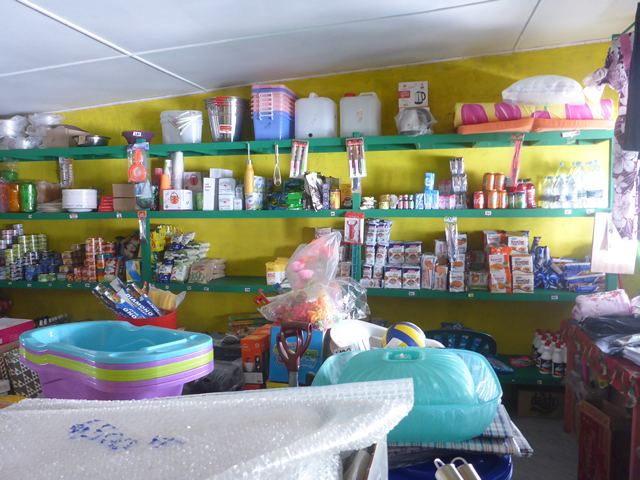
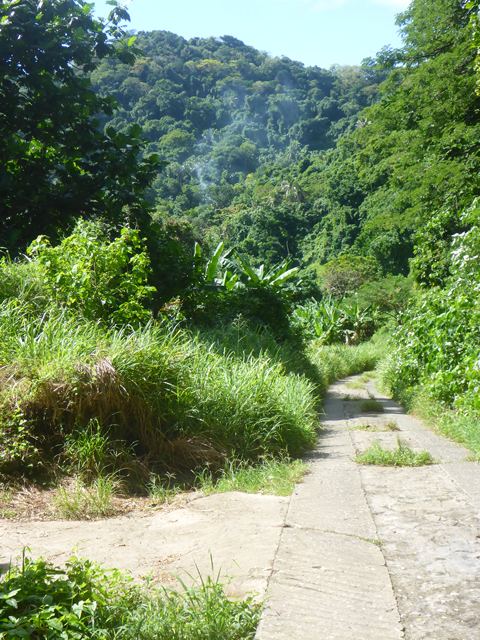
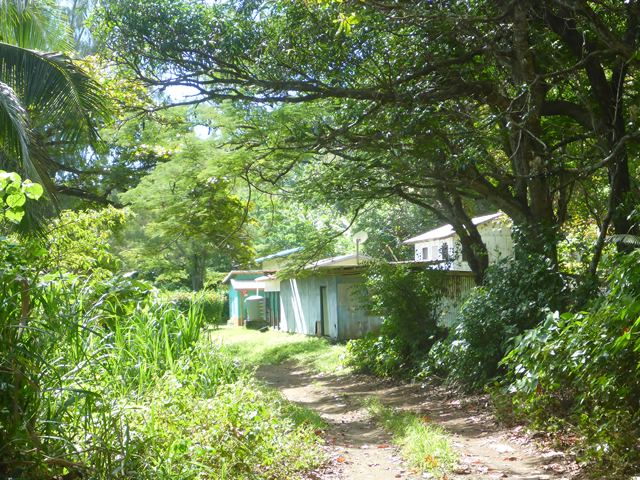
Our first snorkel was around ‘Bat Hill’ and no sooner had we plopped in to the water than Bron and I spotted a ray, with a black and white stripped tail, lying on the bottom. It was a first for us to skirt the submarine rock of a volcanic cliff and it was fascinating. Many brightly coloured lichens clung to the rock and we explored right into one cave finding grooves carved into the rock each being the home of an urchin. Crabs thrived and scampered everywhere and there was a good variety of fish. In the lagoon we explored along the submarine volcano rim more for novelty really than to find anything new.
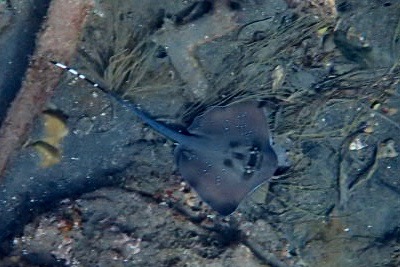

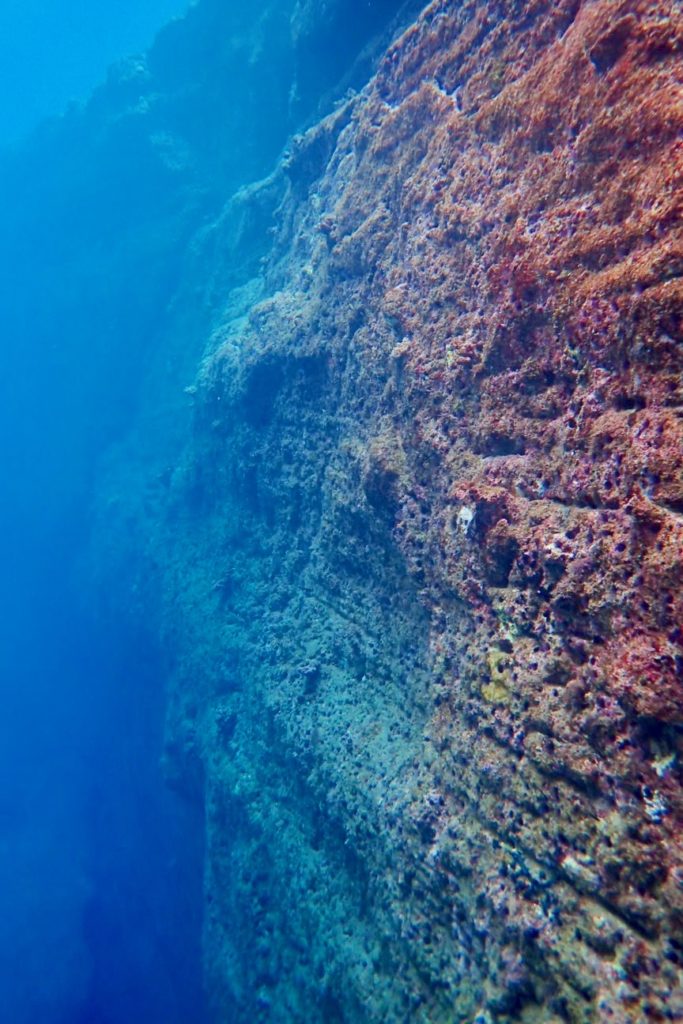
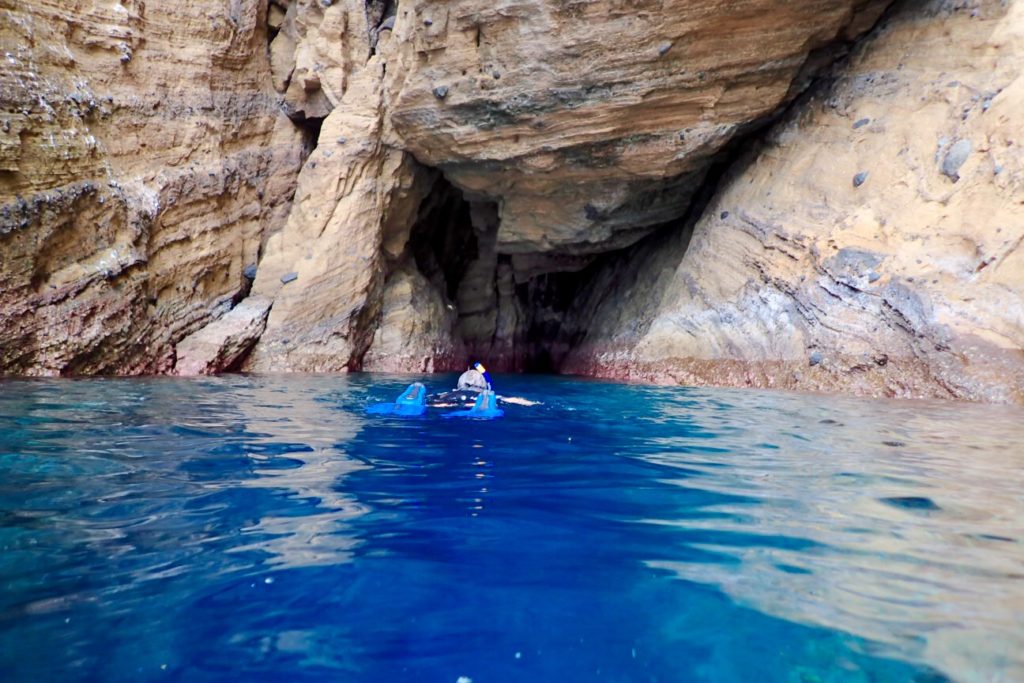
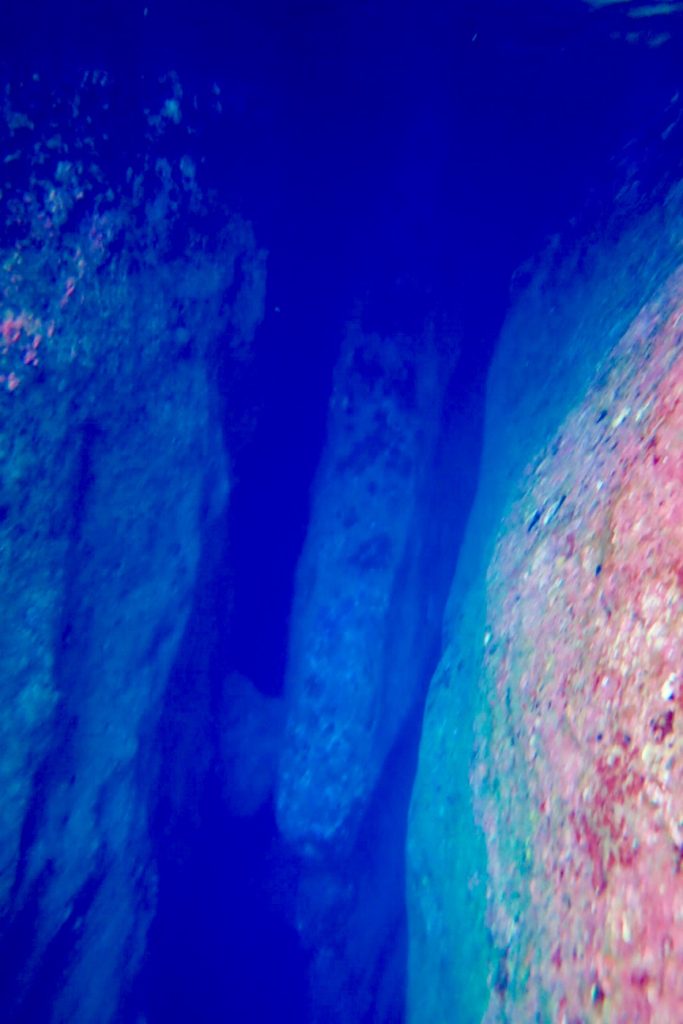
Back into the dinghies we went to ‘our’ beach for a stroll and a closer look at the extraordinary volcanic rock cliffs before another swim between two protective rocky outcrops at the far end of the beach revealed a beautiful many coloured coral garden and plenty of fish set within a thick bottom of ash.
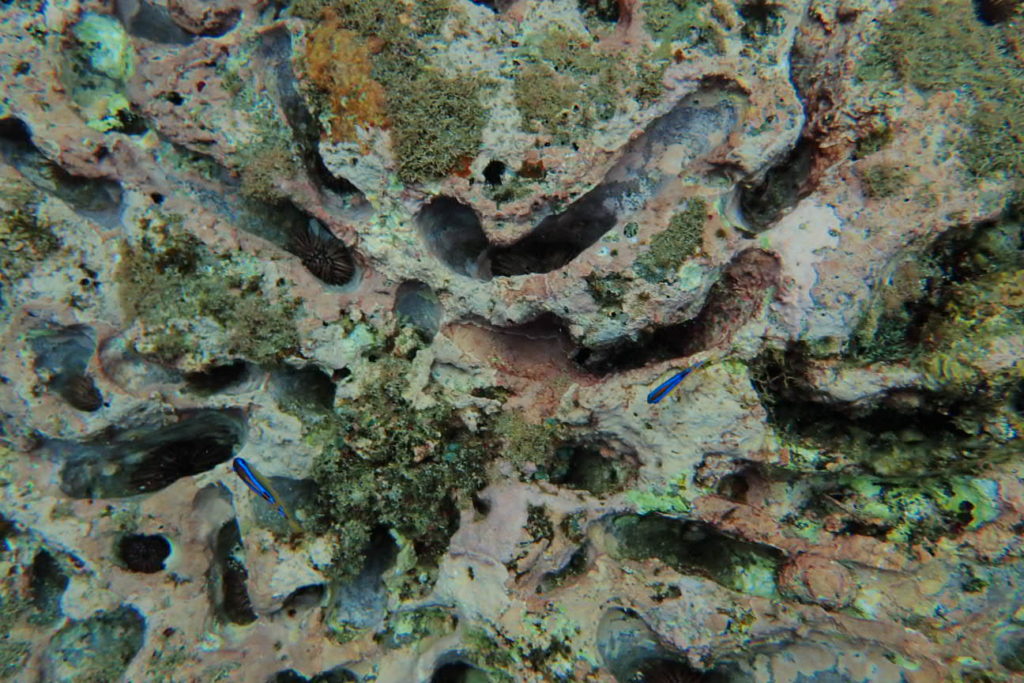
That evening it was Bron’s turn to delight us with Mexican Wraps for supper but not before Rob, true to his decision to do no more fishing, handed over all his fishing gear to Ken who was so pleased he thought Christmas had come early. It was an eventful evening in more ways than one. Making our way back to Zoonie I found my vision was darting from side to side and I hoped a good night’s sleep would rectify the effect two of the “special” little chocolate cakes I had eaten was having on me. Fortunately it did!


As we sailed away the next morning I was assured that the legends and customs of little Ambae would continue as long as its people returned with such faith and loyalty despite nature’s wrath.
Asanvari on Maewo Island
Motoring head to wind in calm conditions on another lovely day the twelve miles to Asanvari on the south west tip of Maewo I wondered how Shirley was getting along distributing the glasses and bras amongst the ladies of Narovorovo; did they feel uplifted and did their new sharp vision enable them to perhaps read a book or make culinary chores like chopping and slicing a lot safer? I hoped so.
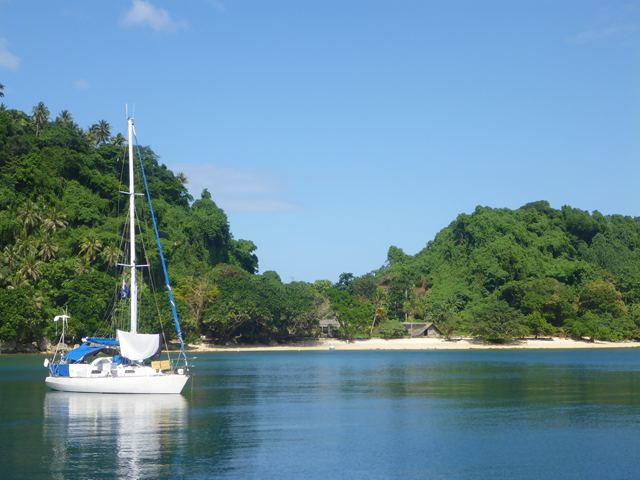
The directional arrows that were once painted on the rocks suggesting the best anchoring area in the bay were long since worn away so we used the combination of chart plotter, the sketch in Miz Mae’s booklet and common sense and dropped the hook just to the left of the beautiful waterfall that cascaded over smooth rock a few metres back from the shore.
On our way to the beach we detoured to the waterfall first as there was a fascinating bath-house style building there set in a pretty garden and we were curious to see if it was open. Ken had been over there first, collecting fresh water and we landed and scrambled up the side of the walled garden to see the fall close up. The photos speak for themselves and I wonder who the ‘Douglas’ was whose name was just legible on his tombstone hidden in the foliage.
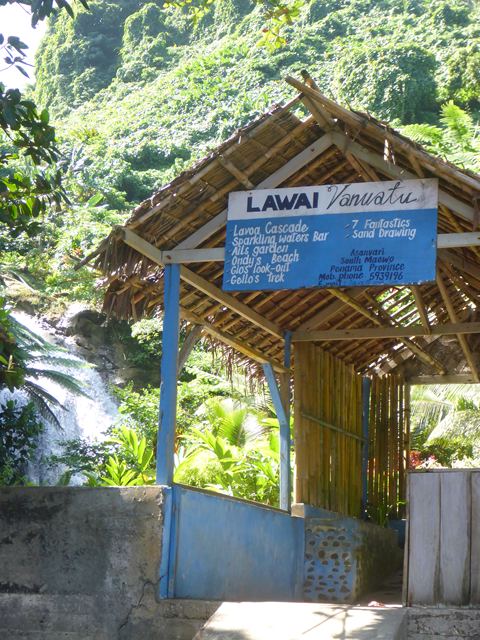
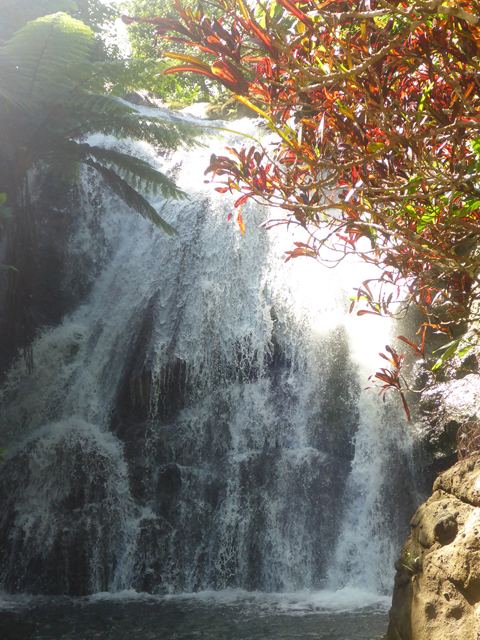
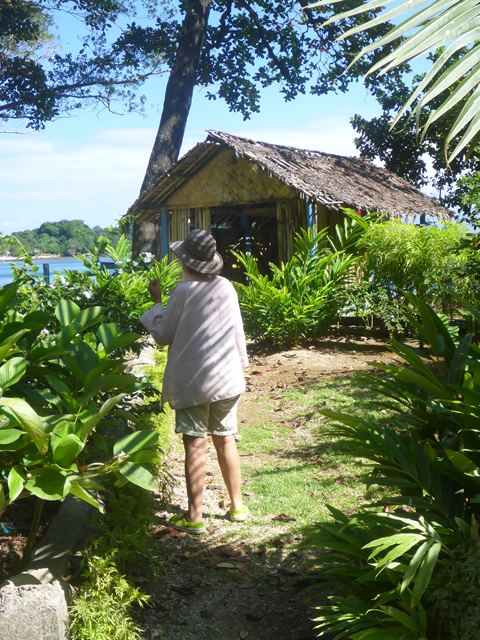
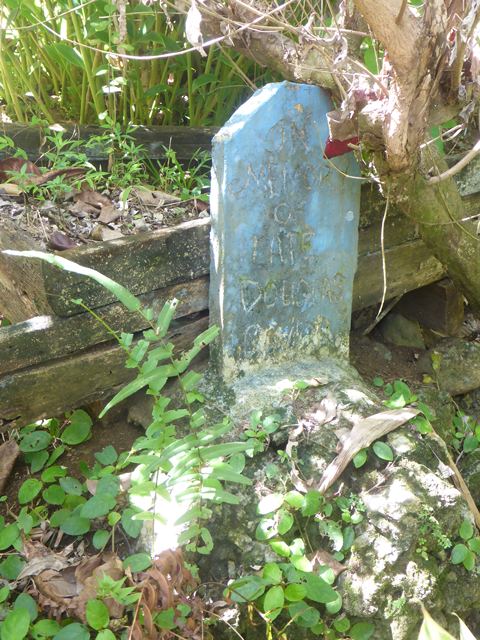
The Spring Water Bar looked as if the chairs could be spread out and iced drinks served up on request at a moments notice. Boatman Bruce came over and said he had taken the barman to another island that morning but he would be back later. In fact he was because he lives in the little hut, we saw his light on until well in to the night.

Nichola Rhind from the yacht Miz Mae, who wrote the invaluable little guide book based on her own findings around 1998 and to whom we are indebted and grateful, suggests this is one of the most beautiful and colourful villages in Vanuatu and we would agree. In fact I think we must be seeing the most beautiful villages altogether as once again it felt as if we were sailing in to Kew Gardens, the grounds are cared for with such thorough love, albeit largely by the cows and chickens, but carefully laid out gardens with hedges and fences showed the human design.
‘On arrival please introduce yourself to Chief Nelson, or in his absence one of his sons, Nixon or Jim.’ Albert strode down the beach to greet us and we learned that Chief Nelson had died, that was 21 years ago after all, one of his sons lived nearby and another in Port Vila.
Albert gave us freedom to wander anywhere and called over young Martin to lead us through the village to the school area. There were plenty of children around to help with the dinghy as they were on their lunch break. Passing homes along the path people would called ‘Hello’ from the dark interiors and we saw their crops in different stages of ripeness, papaya, bananas, pineapple and root vegetables, so there is always plenty to eat.


The soil track opened onto the football pitch where some children joked at Martin with his adult followers and then we walked between school buildings to the open playground area and surrounding homes. Teacher Fred, the headmaster, came for a chat while one young boy clung to his leg, maybe his son.
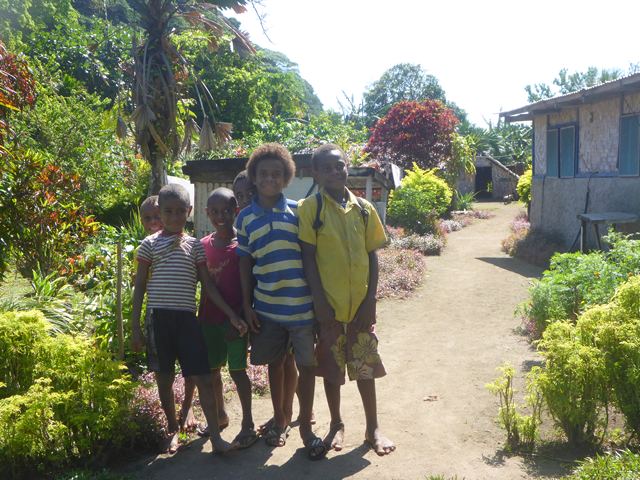
The late Chief Nelson was a benevolent leader of his people and made sure that the village ran in harmony with the surroundings but also in tune with the times. He could see the value of tourism and would organise Custom Dancing and Kava Ceremonies at the request of paying tourists. He even organised for visitors to get married in the Anglican Church on the beach for 22,000 vatu (£157.14) which included the ceremony, custom dancing, food, the church service and singing. One of the many questions I didn’t have time to ask was do they still offer this service?
Through a natural gap in the bank behind the beach we came full circle back towards the anchorage and met Erica who runs the well cared for Guest House and ‘Yacht Club’ built in chief Nelson’s time. Like so many of the small tourist enterprises we came across, built and run by Vanuatuan people, guest houses, restaurants, bars, resorts and this yacht club appear set up in a state of readiness for the off chance some custom will come by. They could do with some advertising if they want more regular business.
On a table in the neat, coral floored and well shaded club there was some fruit and local carvings of dugout canoes with outriggers for 5000 vatu (£35) which would be a good days income if they sold just one. Erica asked if we would like an evening meal but we declined. She told us how her husband is away in Australia picking grapes for at least nine months of the year but sends little money home because not only is his salary low but then the farmer takes off accommodation and living expenses. Was it worth the separation?
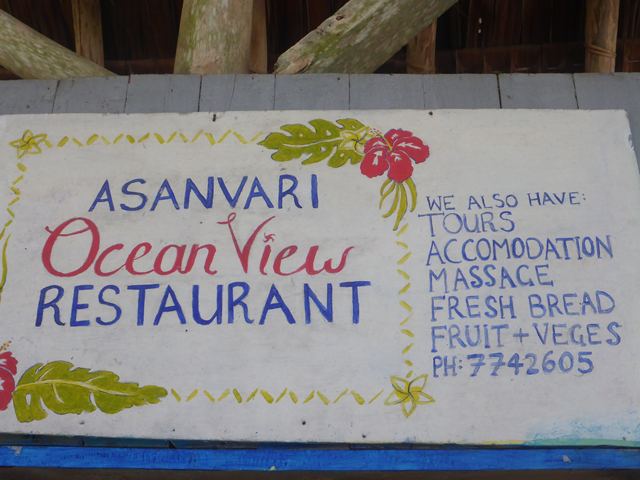

The visitors to her guest house recently have comprised government officials from Vila who stay for one night once a month, so if she could entice more visitors then her husband could come home, but no doubt she has thought of that. It just seemed she could do with some marketing help and a connection in places that encourage people who like the more out of the way holidays maybe with a study bias.
In the afternoon we cooled off with a snorkel and found a different reef state to Miz Mae’s experience. Twenty years ago there were thousands of fish, coral heads supporting large ferns and numerous hard and soft corals but now there is evidence of cyclone damage and virtually no soft corals or ferns. All the bays on the leeward side of the islands may have protection from the south easterly Trade Winds but they are often in the direct firing line of the cyclones spinning down from the equator between November and April.
That evening it was Bron and Ken’s turn to come to us for a curry and games of trionimoes. We offered our old inflatable dinghy to Ken as he would spend the time re-gluing the seams and it could replace his battered fibreglass tender. Would you believe, no sooner than the words came from my mouth than our new in Lagos, Portugal tender decided it wanted some attention. While in NZ we had two major seams opened up and re-stuck so they wouldn’t fail and now leaks are gradually working their way around the remaining seams. The glue used in temperate climates cannot withstand the heat of the tropics for long.


Not only that but both lifting points at the back on top of the floats where the side ropes are attached decided to split within days of eachother and to cap it all the bung decided to go AWAL while we were towing it between anchorages. But super repair man Rob has been busy and all is fixed at the moment, we’re just running out of glue!
Ken likes his early starts and we certainly do not mind them as it often means we arrive in a place and can explore, visit, chat and snorkel in the same day in readiness to move on the following morning while the weather is fair. Were we to stay longer we could arrange guided walks into the jungle to the other side of the island or to waterfalls but with little cash we were happy with the quality and content of our visits.
